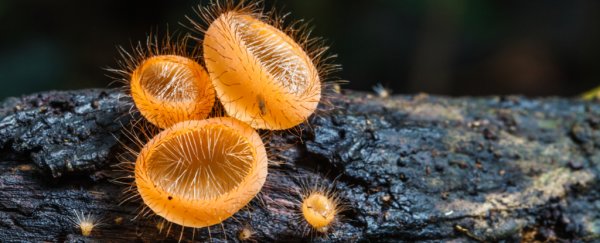Without plants, Earth would never have developed a breathable atmosphere for us all to thrive in. But now it turns out that plants got there with a little help from some of our planet's most peculiar lifeforms - fungi.
According to new research by scientists at the University of Leeds, fungi bridged a very important gap between plants and the soil.
When Earth first formed 4.6 billion years ago, it had almost no atmosphere. As it cooled, an atmosphere developed, but it would have been very toxic to humans, being made up of hydrogen sulfide, methane and carbon dioxide.
Then the planet grew cool enough for liquid water - and with that liquid water came cyanobacteria, which started the process of transforming Earth's atmosphere into an oxygen-rich one.
But it wasn't until the evolution of land-dwelling plants that the atmosphere became rich enough to support animal life, sometime around 400 to 500 million years ago.
And, according to a team of researchers from the University of Leeds, those early plants weren't developed enough to do it on their own. They had not yet evolved roots or vascular systems like plants have today.
Instead - and not dissimilar from symbiotic relationships between plants and fungi today - fungi in the soil transferred phosphorus from the rocks to the plants, which in turn powered plant photosynthesis.
"Photosynthesis by land plants is ultimately responsible for about half of the oxygen generation on Earth, and requires phosphorus, but we currently have a poor understanding of how the global supply of this nutrient to plants works," says one of the team, biogeochemical modeller Benjamin Mills.
"The results of including data on fungal interactions present a significant advance in our understanding of Earth's early development. Our work clearly shows the importance of fungi in the creation of an oxygenated atmosphere."
And, it's important to note, the earliest fossil of a land-living organism is one of a mushroom. Fungi have been around a long time, perhaps even longer than plants.
This is perhaps because fungi have an ability to extract minerals from rocks, whereas plants rely more on organic matter.
There wasn't a lot of that around in those early days of terrestrial life. But when plants photosynthesised carbon dioxide from the atmosphere, they produced carbon - which they passed on to the fungi. The arrangement was mutually beneficial.
The team used a combination of lab experiments using ancient fungi that have survived to the present day and computer modelling.
By observing the fungi in action, they were able to determine that different fungi conducted the phosphorus-carbon exchange at different rates, which in turn influenced how quickly the plants produced oxygen.
This affected how quickly the atmosphere became infused with enough oxygen to be breathable.
"We used a computer model to simulate what might have happened to the climate throughout the Palaeozoic era if the different types of early plant-fungal symbioses were included in the global phosphorus and carbon cycles," says study co-author, plant biologist Katie Field.
"We found the effect was potentially dramatic, with the differences in plant-fungal carbon-for-nutrient exchange greatly altering Earth's climate through plant-powered drawdown of CO2 for photosynthesis, substantially changing the timing of the rise of oxygen in the atmosphere."
Thank you, little slime mould.
The research has been published in the journal Philosophical Transactions B.
